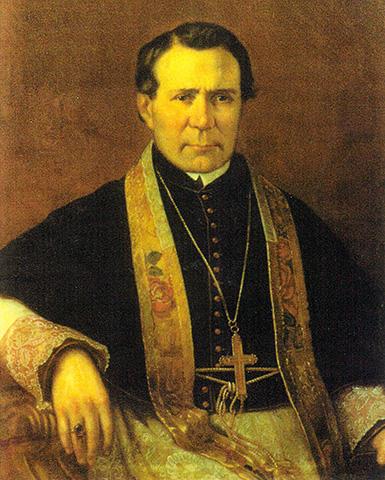Armand-François-Marie de Charbonnel (1802-1891), date inconnue, Berthun, Collège St. Michael, Université de Toronto, PH 03/14CP.
Courtoisie des Archives de l’Archidiocèse catholique de Toronto.

Armand-François-Marie de Charbonnel (1802-1891), date inconnue, Berthun, Collège St. Michael, Université de Toronto, PH 03/14CP.
Courtoisie des Archives de l’Archidiocèse catholique de Toronto.
Armand-François-Marie de Charbonnel (1802-1891), Date Unknown, Berthun, St. Michael’s College, University of Toronto, PH 03/14CP.
Courtesy of the Archives of the Roman Catholic Archdiocese of Toronto (ARCAT).


D’abord et avant tout un prédicateur, on reconnaît toutefois Armand de Charbonnel comme « père et fondateur de la province ecclésiastique de Toronto ». Pendant son épiscopat, d’une durée de dix ans, il fit construire 23 églises, organisa la Société Saint-Vincent-de-Paul, créa des établissements importants : hôpitaux, orphelinats, foyer pour les personnes âgées et des auberges pour jeunes. C’est lui qui a fait venir plusieurs communautés religieuses dans le diocèse pour s’occuper de l’enseignement et de l’assistance sociale, entre autres, les frères des écoles chrétiennes, les pères basiliens, les Sœurs de Saint-Joseph. On lui reconnaît la création d’écoles séparées (il était membre du conseil de l’Instruction publique).
Ordonné prêtre en 1825, puis entré chez les pères sulpiciens en 1826, le jeune prêtre enseigne aux séminaires de Lyon, Paris, Bordeaux et Versailles. En 1838 il décline l’invitation du cardinal Donnet qui lui offre le poste de grand vicaire. Un an plus tard, il refuse la même charge auprès des évêques d’Autun et du Puy. Sa fuite en Amérique n’arrange rien puisqu’on lui offre un évêché dans une colonie anglaise, puis la coadjutorerie en Nouvelle-Orléans; de Charbonnel préfère enseigner à Baltimore. En 1840, il arrive à Montréal et y demeure pendant sept ans. Atteint du typhus, il rentre en France pour se faire soigner.
Le pape Pie XI le mande à Rome en 1850, le nomme deuxième évêque de Toronto et le sacre lui-même dans la chapelle Sixtine, le 26 mai 1850. En 1856, il obtient la division de son territoire pour l’érection des diocèses de London et de Hamilton. Français de naissance et de cœur, Mgr de Charbonnel ne s’était jamais senti à la hauteur de sa tâche, en raison de l’écart linguistique et culturel qu’il y avait entre lui et ses ouailles.
Mgr de Charbonnel démissionne le 26 avril 1860, retourne en France et entre dans l’ordre des Capucins. Il refuse divers honneurs, mais il accepte de servir d’auxiliaire au cardinal de Bonald pendant vingt-deux ans. Né au château de Flachats, en Haute-Loire (France), fils du seigneur Jean-Baptiste de Charbonnel, il est né le 1er décembre 1802. Il meurt en France le 29 mars 1891.
Une école secondaire de langue française de Toronto porte aujourd’hui son nom.
First and foremost a preacher, Armand de Charbonnel is recognized as “father and founder of the ecclesiastical province of Toronto”. During his episcopate, that lasted ten years, he had 23 churches built, organized the Society of St. Vincent de Paul, and founded important institutions such as hospitals, orphanages, retirement homes and youth hostels. He had several religious communities brought into the diocese to take care of education and social assistance, among others, the Christian Brothers, the Basilian Fathers and the Sisters of St. Joseph. He is credited with the creation of separate schools (he was a member of the Council of Public Instruction).
Ordained a priest in 1825, he then joined the Sulpician fathers in 1826 and, as a young priest, taught seminars in Lyon, Paris, Bordeaux and Versailles. In 1838 he declined the invitation of Cardinal Donnet, who offered him the post of vicar. A year later, he turned down the same offer from the Bishops d’Autun and du Puy. His escape to America did not help, as he was offered a bishopric in an English colony, and then a coadjutorship in New Orleans; de Charbonnel preferred to teach in Baltimore. In 1840 he arrived in Montréal and remained there for seven years. Ill with typhus, he returned to France for treatment.
Pope Pius XI called him to Rome in 1850, and ordained him the second bishop of Toronto and the service itself was held in the Sistine Chapel on May 26th, 1850. In 1856, he succeeded in dividing his territory for the erection of the London and the Hamilton dioceses. French by birth and by affection, Bishop de Charbonnel had never felt up to his task, due to the linguistic and cultural gap that existed between him and his flock.
Bishop de Charbonnel resigned on April 26th, 1860, returned to France and entered the Capuchin Order. He refused various honours, but he agreed to serve as an auxiliary to Cardinal de Bonald for twenty-two years. He was born on December 1st, 1802, at Castle Flachats, in Haute-Loire (France), son of Lord Jean-Baptiste de Charbonnel. He died in France on March 29th, 1891.
A French-language Toronto high school bears his name today.
Réseau du patrimoine franco-ontarien
Source
Archives de l’Archidiocèse catholique de Toronto
Les Archives de l’Archidiocèse catholique de Toronto acquièrent, conservent et rendent accessibles les dossiers officiels de l’Archidiocèse de Toronto. Les Archives conservent également les documents additionnels qui reflètent l’œuvre de l’Église au sein de de l’archidiocèse.
Archives of the Roman Catholic Archdiocese of Toronto (ARCAT)
The Archives of the Roman Catholic Archdiocese of Toronto (ARCAT) collects, preserves and makes available for research the official records of the Archdiocese of Toronto and those ancillary records which reflect the work of the Church within the Archdiocese.
Info: 1155, rue Yonge, pièce 505 , Toronto, ON, M4T 1W2
Tel: 416-934-3400 ext. 501
archtoronto.org/archives